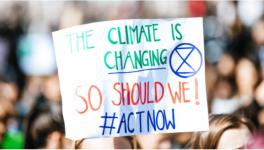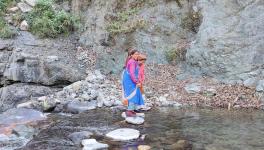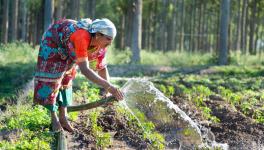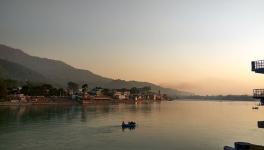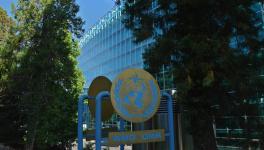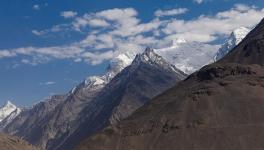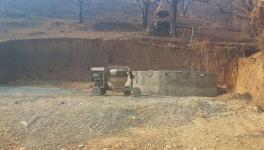Heat Wave Challenges: ‘Business as Usual’ Won’t Work Any Longer
“Red Hot Planet”, wrote Pratap Bhanu Mehta in one of his columns published in the Indian Express on May 4, 2022. Mehta spoke of the imminent challenges ahead due to the impact of climate change and how it was affecting people around the globe, particularly in the global South.
“Like Nero, we fiddle as the world burns”, he wrote, adding that: “Climate deniers are not the real challenge. Those who do not deny climate change are imprisoned by a sense of unreality.”
Whether real or surreal, the truth of the matter is that temperatures have started hitting the poor the hardest. According to the magazine, Nature Volunteers, the maximum temperatures recorded in some Indian cities are Lucknow-47, Delhi-47, Agra-45, Nagpur-49, Kota- 48, Hyderabad-45, Pune-42, Ahmedabad-46, Mumbai-42, Nashik-40, Bangalore-40 and Indore-46. It is feared that soon most of these cities may cross 50 degrees Celsius temperature (figures in degrees Celsius).
Just to give an example as to what this means. The geyser in homes used to heat water during winters has a thermostat adjusted at 50 degrees. We all know what these rising temperatures mean. People living in these cities are virtually living in ovens.
In a warning on May 7, the India Meteorological Department or IMD said there would be another heat wave spell in Northern India. The situation is worsening.
Another study said that since nearly a third of South Asia’s population depended on outdoor work, with rising temperatures it would be extremely difficult for them to even meet their bare minimum survival needs.
There was continuous fire for over 10 days at the Bhalswa solid waste landfill site in Delhi. There are three such sites in the capital city and, apparently, there is a fire in all these sites. The Supreme Court recently, in an observation, pointed out that these sites were turning out to be minarets of modern India and would soon surpass the height of Qutub Minar. However, the sarcasm did not seem to cut much ice as it is “business as usual” for the Delhi municipality. Most of the waste generated from the city is dumped without treatment and continues to be a permanent source of methane, which is responsible for such fires.
The summer of 2022, many say, is beating all previous records, as is already evident from the rising temperatures. The poor and the marginalised find it more difficult to meet the challenges of rising temperatures. With little humidity, the situation is becoming worse.
Invest in Adaptation Strategies
This rise in temperatures will soon have a cascading effect. More heat-related deaths will be reported soon. The water crisis will aggravate. Already a large number of cities are finding it difficult to provide a minimum of 135 LPCD (litres per capita, per day) of water, the minimum prescribed norm, to its people. Some towns are providing water twice a week. This will hit health services in cities and increase the burden on them.
Forest fires are raging in the hill states of Himachal Pradesh and Uttarakhand. The loss to biodiversity is phenomenal.
A "business as usual" approach cannot work in the current situation. What is needed is a major disruption to break the inertia.
The focus must be on adaptive strategies, with simultaneous efforts to ensure mitigation strategies. Some areas of priorities are:
· Mobility: The city mobility plans must be completely inversed. Instead of building more flyovers and encroaching on spaces for pedestrians and cyclists, thesee should be strengthened. Various studies across the country suggest that nearly 80% of the commute in urban India is less than 6 km. If that is the case, then there must be more cycle tracks, public transport and pedestrianisation.
In a recent cycle exhibition in Delhi, a call was made to manufacturers to form a consortium to help cities prepare their mobility plans and focus on bicycle tracks. The current model of creating more space for giant guzzlers is not sustainable. Not only do they increase the fossil fuel intake, but also carbon emissions and pollution in cities.
· Housing and Building Plans: The other major factor contributing to heat island effects is the unscientific way and form of construction of houses in the cities. Instead of designs that consume less energy for cooling and heating of houses, most of the construction material being used enhances the heat island effect. Glass typologies have dominated construction designs in the past few decades. We now realise how much energy is required for cooling purposes for houses with glass walls. There is no competitive design mechanism that encourages planners and designers to ensure that energy-efficient designs are prepared. The use of indigenous materials and timber should be promoted instead of importing these from abroad.
· Solid Waste Management: According to a report, nearly 1.50 lakh MTPD (metric tonnes per day) of solid waste is generated daily. Almost 15,000 tonnes remains exposed every day. Of the total waste collected, just 20% (27,000 tonnes per day) is processed and the remaining 80% (1,08,000 tonnes) is dumped at landfill sites, such as Bhalswa among others.
According to a paper published in the Royal Society Open Science magazine, urban areas alone generate 1,70,000 tonnes of waste per day. There are completely unsustainable strategies in place. The Swachh Bharat Mission, version 1.0 and even version 2.0, favour waste-to-energy plants. This will solve the problem at all, rather it will compound it.
The effort in cities to collect all the waste and then run the vehicles carrying this waste to energy plants further increases carbon footprint. Also, none of these waste-to-energy plants are functional in the country. What is required, therefore, is to revisit the ‘5 Rs’ --reduce, recycle, refuse, reuse and repurpose. Segregation and treatment of waste at source must be the guiding principle.
· Urban Commons: Recent decades have seen massive plunder of urban commons in the name of developmental projects under the Jawaharlal Nehru National Urban Renewal Mission or JNNURM, SCP (Smart City Plan), real estate development, construction and widening of roads and flyovers. This exercise has encroached upon urban commons that existed for a long time. A few examples are the completely aggrandising water bodies in Gorakhpur in Uttar Pradesh and Gurgaon in Haryana; the proposed developmental projects in Andaman & Nicobar Islands and Lakshadweep; the Delhi Master Plan 2041, envisioning of land pooling and literally forcing kisans to part with their agricultural land for housing and real estate development; denuding forest cover for construction of hydropower projects and dams for providing water to large cities from Renuka Lake in Himachal Pradesh to Delhi etc. The urban commons comprise not just water bodies but also parks and playgrounds. The pace at which playgrounds are termed as useless and usurped for real estate development is quite alarming.
·Ensure more green spaces: Plant more trees and ensure that green spaces are not taken over. The cutting of trees for various developmental projects further enhances the heat island effect. On a personal note, in Delhi, normally I cycle from Green Park via AIIMS to Ashoka Road. The temperature difference is easily felt. Green Park and AIIMS are relatively warmer whereas the stretch from INA to Sunehri Bagh is cooler. Once again as one reaches the Central Vista region where trees were chopped down, one can feel the heat. Urban forestry must be revisited and more trees must be planted within the city premises.
There are other reasons as well for the rise in temperatures in Indian cities. However, the above four areas require immediate intervention both proactively and regressively.
June 5, is World Environment Day. This year the theme is “Only one Earth”. The people and the planet have coexisted for long. It is time for restitution of planet Earth, and not just rehabilitation, which many environmentalists argue for, to ensure a liveable future for all.
The writer is former Deputy Mayor of Shimla, Himachal Pradesh. The views are personal.
Get the latest reports & analysis with people's perspective on Protests, movements & deep analytical videos, discussions of the current affairs in your Telegram app. Subscribe to NewsClick's Telegram channel & get Real-Time updates on stories, as they get published on our website.









